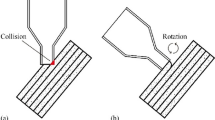Abstract
This paper highlights the process of developing compliant mechanisms. Because of their high precision and the absence of friction compliant mechanisms are especially suitable for the use in micro manufacturing. In the following a systematic methodology of the development process is presented, including the design process, the realization of a mechanism and an application for feed units. At the first stage of design the topology of a compliant mechanism and the geometry of the flexure hinges are generated applying optimization methods. Afterwards efficient modeling strategies are applied to ensure dynamic models with high accuracy and manageable size for further investigations. Using these models an open-loop control is designed by means of mathematical trajectory optimization. At the final stage models and open-loop control are applied to design a closed-loop control completing the feed unit. This holistic approach reduces time and effort of the development process significantly. It supports the developer in creating reliable and innovative compliant mechanisms for a wide range of applications.








Similar content being viewed by others
References
Antoulas A (2005) Approximation of large-scale dynamical systems. Soc Ind Math. Philadelphia, PA
Bendsoe M, Sigmund O (2004) Topology optimization: theory, methods and applications. Springer, Berlin
Dirksen F, Anselmann M, Zohdi T, Lammering R (2013) Incorporation of flexural hinge fatigue-life cycle criteria into the topological design of compliant small-scale devices. Precis Eng 37(3):531–541
Dirksen F, Berg T, Lammering R, Zohdi TI (2012) Topology synthesis of large-displacement compliant mechanisms with specific output motion paths. Proc Appl Math Mech 12(1):801–804
Dirksen F, Lammering R (2011) On mechanical properties of planar flexure hinges of compliant mechanisms. Mech Sci 2(1):109–117 (Special issue—future directions in compliant mechanisms)
Howell L, Midha A (1994) A method for the design of compliant mechanisms with small-length flexural pivots. J Mech Design 116(1):280–290
Kohrs P, Hoffmann S, Wulfsberg JP (2010) Implementation of a flexure based feed unit for the square foot manufacturing concept. In: Proceedings of the 10th euspen international conference, vol 2, Delft, pp 91–94
Kosmol P (2010) Optimierung und Approximation. de Gruyter
Lobontiu N, Garcia E (2003) Two-axis flexure hinges with axially-collocated and symmetric notches. Comput Struct 81(13):1329–1341
Lobontiu N (2003) Compliant mechanisms: design of flexure hinges. CRC Press, Boca Raton
Lunze J (2010) Regelungstechnik 2 Springer-Lehrbuch. Springer, Berlin
Nocedal J, Wright SJ (2006) Numerical optimization. Springer, Berlin
Papageorgiou M, Leibold M, Buss M (2012) Optimierung: Statische, dynamische, stochastische Verfahren für die Anwendung. Springer, Berlin
Pilkey WD, Pilkey D (2008) Peterson’s stress concentration factors. Wiley, New York
Soppa A (2011) Krylov-Unterraum basierte Modellreduktion zur Simulation von Werkzeugmaschinen. Technische Universität Braunschweig. Dissertation
Wulfsberg JP, Kohrs P, Grimske S, Röhlig B (2013) Square foot manufacturing: a new approach for desktop-sized reconfigurable machine tools. In: Schuh G, Neugebauer R, Uhlmann E (eds) Future trends in production engineering. Springer, Berlin, pp 201–208
Zettl B, Szyszkowski W, Zhang W (2005) Accurate low dof modeling of a planar compliant mechanism with flexure hinges: the equivalent beam methodology. Precis Eng 29(2):237–245
Acknowledgments
The financial support of the German Research Foundation within the priority program SPP 1476 “Small machine tools for small work pieces” is gratefully acknowledged.
Author information
Authors and Affiliations
Corresponding author
Rights and permissions
About this article
Cite this article
Wulfsberg, J.P., Lammering, R., Schuster, T. et al. A novel methodology for the development of compliant mechanisms with application to feed units. Prod. Eng. Res. Devel. 7, 503–510 (2013). https://doi.org/10.1007/s11740-013-0472-4
Received:
Accepted:
Published:
Issue Date:
DOI: https://doi.org/10.1007/s11740-013-0472-4




